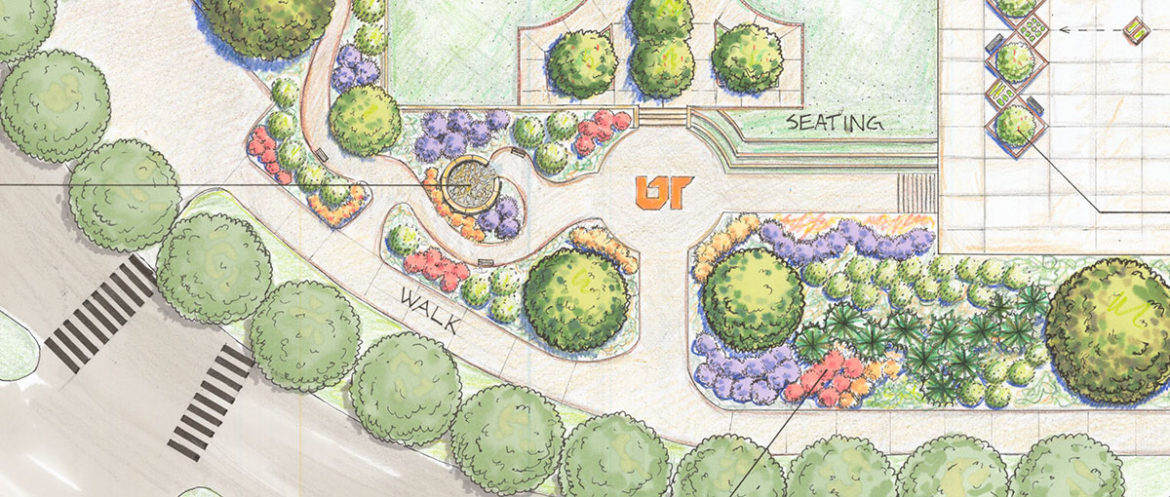Snowed in on campus one Friday afternoon, Chris Weller (’13) was thinking about fresh fruit. Specifically, he was thinking about the UMass Permaculture Initiative, a pioneering project with extensive campus gardens and orchards. He wondered if a project like it would work at UT. The climate is good and the campus is large enough. In his notebook, Weller wrote the words “Big Orange Orchard.”
Meanwhile, senior chemical engineering student Neil Brown was thinking along the same lines. Brown already had considerable experience in campus food programs. After returning to campus for his sophomore year in 2011, he realized how much he missed being able to eat fresh produce from his home garden in Kingsport, Tennessee. That experience inspired him to establish a community garden on campus along with Candice Lawton (’14). From its beginning, Project VEGGIE (Vols Educating about Growing Gardens and Inspiring Environmentalism) attracted participation from a wide range of students—including Weller, whose family owns a farm in Alder Springs, Tennessee.
Like Weller, Brown was aware of the UMass Permaculture Initiative, which provides a huge amount of fresh food to residence halls and individual students at the University of Massachusetts Amherst, and similar projects like Seattle’s Beacon Food Forest. Also influenced by the thinking of environmentalists like Bill McKibben (whose book Eaarth was the 2013 Life of the Mind selection), he was thinking about the next steps in growing fresh food on campus. The two brought their ideas together and began preparing to plant the seeds of the Big Orange Orchard.
The project is not a literal orchard in the sense of a single area where fruit trees are concentrated, but a series of self-sustaining plantings that are low-maintenance and well suited to the region. Initial candidates for growing include pawpaw, persimmon, and plum trees; Asian pear, a disease-resistant tree whose fruit is similar to apples; and several varieties of berries.
“We want students and faculty and staff to go outside and on their way to class or to their office, pick some fresh fruit on campus and eat it,” says Brown.
Initial efforts have focused on planning and working to obtain support and funding. Associate Professor Garry Menendez had his landscape architecture students draft master plans for a central campus location. While that area has been set aside as “too ambitious for now,” in Brown’s words, the student designs continue to inspire the organizers. A campus survey showed overwhelming support for the project—“out of 2,000 replies, all but two were positive,” says Weller.
While not yet officially approved by the university, Big Orange Orchard has also found backing from the Student Government Association, which unanimously passed a resolution of support in March.
“I decided to sponsor the legislation because I felt that BOO would be a great addition to the campus and be very beneficial to the university as a whole,” says SGA Senator Julianna Burchett, who co-sponsored the resolution and will work with the project as chair of the Committee on Environment and Sustainability. In the coming year, Burchett says, the committee “will be working on sources of funding for the project, as well as with UT landscaping and administration on how this project could potentially be incorporated into the master plan.”
Initial plantings tentatively planned for fall will focus on a plot near the Presidential Court Café where food can be easily harvested and used in the dining facility. Also in the works is an online map showing the location of current edibles on campus, such as the Blueberry Falls area adjacent to Claxton Education Complex.
With a second orchard plot planned for Knoxville Botanical Gardens, Weller hopes the project will extend further beyond campus, eventually becoming part of a network of new and existing community gardens and orchards throughout the city. “I can see it as a force uniting neighborhoods,” he says. Advanced phases of the project are outlined for the next ten years.
As later stages of the plans are carried out over the next decade, all those involved see the Big Orange Orchard as making a significant contribution to the quality of campus life. “I want UT to be a leading example. We won’t just be preserving what we have now but will actually be making things better,” Weller says. “We’re really excited.”
For more information on the Big Orange Orchard, contact Neil Brown, mbrow104@vols.utk.edu, or Chris Weller, cjweller89@gmail.com.
UPDATE (12/18/14)
Even in the cold and dark of midwinter, the Big Orange Orchard is still taking root. Brown and Weller are working to establish the initial “proof of concept” project at the Knoxville Botanical Gardens and Arboretum. Funding for this initial stage is being raised through UT’s new VOLstarter crowdfunding initiative. You can learn more about the orchard, view a video with Neil Brown, and support the project with a donation of any size at tiny.utk.edu/BOOstarter.
Illustration: Detail of a proposal drawn by landscape architecture student Jeran Guffey.


3 comments
Yes! We need this! The only thing about going to UT I don’t like is how much I miss my farm. It’s do hard to live in the city when you are from a rural area.
What a brilliant idea! And why had it not been thought of before? A fresh pear on the way to class- it would relieve stress, boost your spirit, and be healthy. Better than a pill! And beautiful, besides.
This is a wonderful idea! It would allow the university to serve much healthier and tastier food. Plus, educating students about gardening is a wonderful idea. I wish we had something like this at UT when I was a student. The landscape architect students are already involved which provides them with hands-on experience. Perhaps the Food Science and culinary students could become involved too. Good luck!
Comments are closed.